 August 2020
Beautiful Biodiversity
 An iconic northwoods animal, moose may be observed in far northeast parks such as Grand Portage State Park. PHOTO: Travis Novitsky
“In diversity there is beauty and there is strength.”
~Maya Angelou
The varied landscapes protected and managed within our state public lands provide refuge and habitat for the highly diverse wildlife of Minnesota—more than 700 species of mammals, birds, fishes, reptiles and amphibians. If you include invertebrates such as insects, spiders and mussels, that's over 20,000 different species that we share our home with.
The trick is to know where, when and how to spot your favorite critter. For instance, while you want to make a lot of noise if you see signs of black bears, birds are shy and you might want to move stealthily. Scat can also help you know who broke trail before you.
Whether you are looking to catch a glimpse—or dinner—or a photograph, we hope you enjoy your time outdoors and its great diverse wildlife.
Happy adventures and remember: Stay safe, healthy, and six feet away from others!

Charismatic Megafauna of the Prairie: Southwestern Minnesota
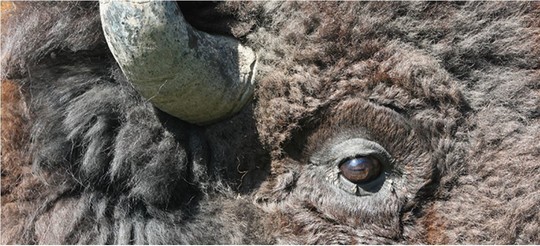 The bison at MN state parks are part of the Minnesota Bison Conservation Herd, managed in partnership between the Minnesota DNR and the Minnesota Zoo, to preserve genetically diverse bison to give bison a chance at a healthy future.
The abundant rock outcrops and shallow soil at Blue Mounds State Park prevented much of the land from being plowed, providing park visitors today with a glimpse of Minnesota's tallgrass prairie and the bison who existed on this landscape for millennia.
Tune in to our "bison radio station" and drive the range at Minneopa State Park while learning about the herd. Bison are most active in the morning or later in the afternoon, as they move around while eating. Expect the unexpected. You may have to wait while they cross the road or lie down in front of your vehicle. Bison are wild and may be out of sight during your visit. More about bison.
The Fastest Animal on the Planet: North Shore and Mississippi River Bluffs
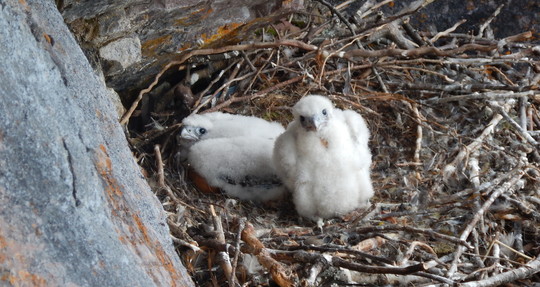 Peregrine falcon chicks in the eyrie (nest) at Tettegouche State Park. PHOTO: Kurt Mead
Peregrine falcons are the fastest animal on Earth and feed exclusively on birds. They disappeared from the Midwest in the 1960s due to widespread use of the pesticide DDT. Minnesota’s first wild-nesting peregrines nested successfully at Tettegouche State Park in 1988. Today, two to three pairs of peregrines nest at Tettegouche most years. Look for them spring through summer on Palisade Head, on Shovel Point, and other cliff sites along the North Shore. More about peregrines.
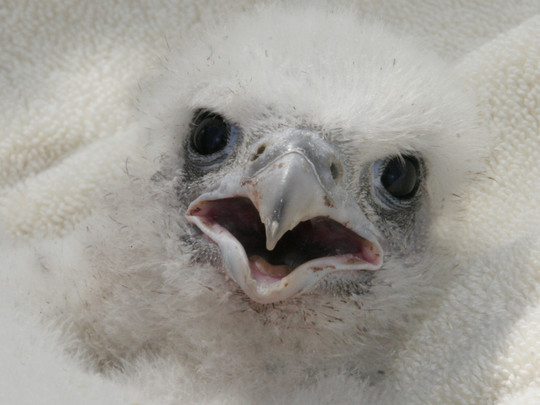 Peregrine falcon chick close up. PHOTO: Carrol Henderson
Dinosaur Fish: Northern and Eastern Minnesota
 A prehistoric species, the lake sturgeon (aka rubbernose sturgeon) can be found in large clear rivers and lakes, including the Red River at Red River State Recreation Area. The largest historical record of lake sturgeon in Minnesota dates from 1903, weighing 400 pounds and measuring 180 inches long. Among Great Lakes Indians, the Lake Sturgeon has been the most respected of all fish. Ojibwe refer to it as Nahmay or Namé, meaning the king of fish. More about the sturgeon.
Slithering in Southeastern Minnesota
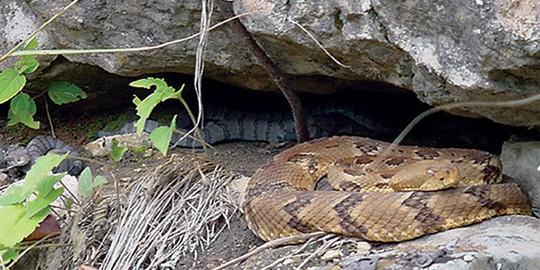 Female timber rattlesnake with newborns in the background. PHOTO: Jaime Edwards
Minnesota is home to 17 species of snakes; six are listed as either threatened or special concern. Minnesota state parks are working to protect rare species like the timber rattlesnake, bullsnake, and plains hognose snake.
The timber rattlesnake is only found in the blufflands of southeastern Minnesota. This snake uses heat-sensing pits located on its face to determine the proximity of prey and to direct its strike. It plays an important role in reducing rodent populations, thus minimizing the spread of rodent-borne diseases and viruses (e.g. Lyme disease). More about snakes.
Aeronautical Marvel
 Elfin Skimmer captured on camera by our naturalist at Tettegouche State Park. PHOTO: Kurt Mead
(No, we're not talking about Amelia Earhart.)
Dragonflies have been buzzing over the landscape for over 300 million years. These aeronautical marvels can hover and glide while pursuing prey species like mosquitoes, at speeds up to 29 inches per second. The Elfin Skimmer, the smallest dragonfly in Minnesota and North America, is only .8 inches long. Elfin Skimmer males are powdery blue, while females are black and yellow, resembling a wasp and have been observed in Itasca County, trapped in carnivorous sundew plants. More about dragonflies.
Minnesota's State Bird?
With over fifty different species, mosquitoes are so common in Minnesota that many call them our "state bird." (The state bird is the loon!) While we don't have a lovely picture to share and guess you will not be seeking an encounter, we do have tips to make your time with skeeters tolerable:
-
Avoid damp and brushy areas, especially at dawn and dusk. If you are in a quiet area, listen for the hum of mosquitoes rising and breaking the silence.
-
Cover up: Wear a head net, light-colored clothing, long sleeves, long pants and shoes with socks. (Clothing also helps prevent tickborne diseases, esp. if you pre-treat with permethrin.)
-
Insect repellent: DEET is most effective but not as safe for young children and should not be used for babies. DEET-free repellents and 30% oil of lemon eucalyptus are somewhat effective, but may need to be re-applied.
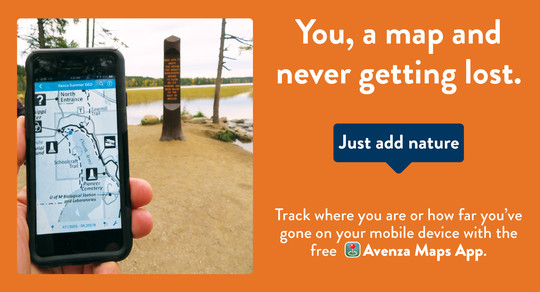
 Keep Wildlife Wild
 Eastern gray squirrel. PHOTO: USFWS
Protect yourself and wildlife by following these simple tips:
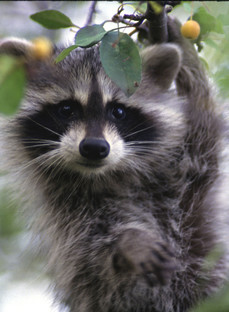
When camping, store all food in your vehicle or a food box. Raccoons have five fingers and can open your cooler or container.
Do not feed wildlife, as they can get sick from human food and become aggressive as they learn to beg from humans.
Pack it in - Pack it out: Compostable food scraps (e.g. apple cores, orange peels) are not part of the natural diet of Minnesota wildlife and can impact digestion and health.
Keep a safe distance from wildlife: Yes, even the cute lil' chipmunk visiting your picnic table. Wild animals are unpredictable and can transmit diseases and viruses.
Raccoon. PHOTO: USFWS
|
Brown bear, brown bear: A bit of noise will be enough to scare them off, and a clean campsite means they won't be interested in paying a visit.
Who else not to feed? The deer. Even at home. Starting July 1, Dakota, Hennepin, Ramsey, Rice, Scott and Washington counties were added to deer feeding and attractant bans. Keeping food that entices deer off your lawns helps prevent the close contact between deer that can transmit chronic wasting disease.
 Trail Games
Whose Scat Is That?
You may not see the moose or deer, but you can learn if they've been around just by looking down.
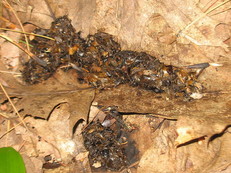
(1)
Cylindrical in shape with rounded or broken ends, typically dark in color. Likely to contain berries.
|
|
(2)
Oval, pellet-like, about half an inch in diameter, dark brown or black in color, and scattered in proportional piles.
|
|
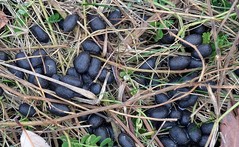 |
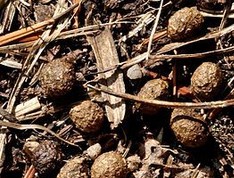
(3)
Pea-sized, usually black, light-brown or green in color. Filled with plant and grass pieces.
|
|
(4)
Dog-like droppings, pointy at one end and full of fur, feathers, tiny bones, seeds and berries. Fresh droppings have a distinctively musky smell.
|
|
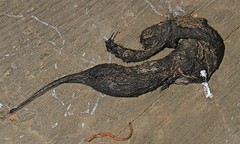 |
|
(5)
Coarse and black, full of fish and crayfish parts and sometimes feathers or fur. Becomes pale and crumbly as it dries. Very musky and fishy smelling. Found on grass mounds and rocks along streams, lakes and rivers.
|
|
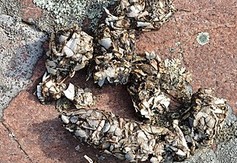 |
|
(6)
Form “cow pies.” The scat of the young appear as a stack of cookie-sized wafers. Belongs to a very large mammal.
|
|
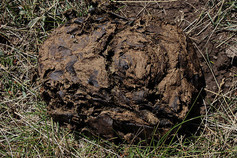 |
|
(7)
Tubular and twisted with tapered ends. When fresh, it has a strong smell. This scat should always be picked up from trails and deposited in the nearest trash can.
|
|
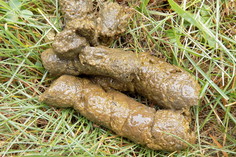 |
Scroll down to the blue section for answers.
More about poop.
|